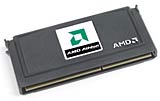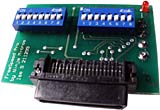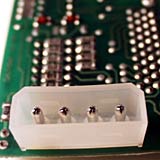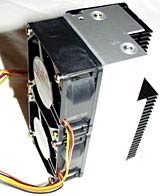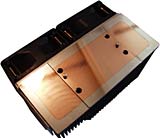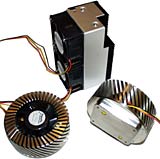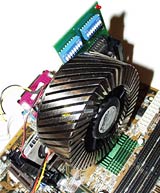
Athlon Overclocking Adventure
Review date: 13 March 2000.Last modified 03-Dec-2011.
Brute, animal power.
Sheer, screaming, raving mad, speed.
Mumbo, folks.
You want it. You might not need it, but you want it. And here's how to get it, on the cheap.
In the PC speed stakes at the moment, the big name is not Intel. Sure, they've shipped Pentium III processors that run at most impressive clock speeds, but they haven't shipped a whole lot of them - the faster P-IIIs are in short supply. They're hard enough for big system manufacturers to get hold of, let alone regular people.
AMD, on the other hand, has been pretty much meeting the high demand for its Athlon processors. Which are faster, and cheaper.
An Athlon will slightly outpace an equivalently clocked Pentium III. Even the new, faster "Coppermine" P-IIIs (designated with an E after their model name, or an EB if they use the new 133MHz Front Side Bus speed) can't quite catch an Athlon. And although Athlon supplies have also suffered occasional shortages of one model or another, they're generally easily available all over the place to ordinary consumers, as long as you don't want the very newest models.
At the moment, the "very newest" Athlon is the recently announced one gigahertz (1000MHz) part. AMD made a big production out of hitting the 1GHz mark, but that big round number is actually no more significant than, say, the arrival of the year 2000. The 1GHz Athlon has no significant architectural differences from previous versions, and is only as much faster than, say, the easily available 850MHz unit, as you'd expect it to be from the clock speed.
And fast it may be, but cheap it is not. The top-end processors in a given range always deliver considerably lower performance per dollar than the low-end models, and so it is with Athlons; AMD's 1,000 unit price to manufacturers for the 1GHz chip is a hefty $US1,299 per CPU. Consumers buying only one CPU, over the counter, can expect to see an even more imposing figure on the sticker when the new processor makes it to the retail market; here in Australia, you're talking well over $AU2000.
Back in the real world, you can get more modest Athlons for much more reasonable prices. Athlons are all presently priced cheaper than equivalently clocked P-IIIs. The list prices generally run about 20% cheaper at deep discount dealers, who may or may not have stock, and may or may not charge reasonable shipping fees. The P-III shortages, though, mean that people that actually have stock of the Intel processors are usually the ones charging rather more for 'em. Especially in the higher speed ranges, Athlons are drastically cheaper at the moment.
The slowest Athlon still being made by AMD is the 600MHz unit, which sells here in Australia for $AU520 or so. There are plenty of U.S. dealers selling them for well under $US250. This CPU can pretty much mix it with a 650MHz Coppermine P-III, which you probably won't be able to buy; if you could, you'd be looking at $AU770 for it.
The older 500MHz Athlons are still available, too, for $AU470 or so. They're more or less a match for a P-III 550E, which you may be able to buy - 500E and 550Es are at least in stock here and there in Australia. My sponsors Aus PC Market have 550Es as I write this; if you're in Australia or New Zealand and want to hop in and buy one before they're all snapped up again, click here!
But for a 550E, you'll pay about $AU650.
So there must be a catch, I hear you say. You're right. There is.
Athlons use a special CPU connector, "Slot A", which is mechanically identical to the Intel Slot 1 connector but electrically completely different. This means Athlons need their own special motherboards; upgrade to an Athlon from a system containing anything but another Athlon and you're going to need a new motherboard. A motherboard swap is a pretty serious procedure; if you're running Windows, it's unlikely you'll be able to pull it off without reinstalling the operating system.
Then again, upgrading to a current model P-III may require you to trade in your motherboard, too. Flip Chip Pin Grid Array (FC-PGA) Coppermine P-IIIs can be used on various recent Slot 1 boards by using an appropriate "slotket" adaptor (I review a couple here), and all pre-Coppermine P-IIIs are Slot 1 processors that'll also work on a plethora of motherboards. If your motherboard, however, doesn't support the 1.6 volt supply that the Coppermines want, you can't use one. And if you want to use a 133MHz Front Side Bus (FSB) P-III, you'll need a motherboard that can handle it. Some late model boards using Intel's old BX chipset can do 133MHz FSB passably well (like, for example, the Abit BF6, which I talk about here). But BX boards aren't meant to run that fast, and overclocking the FSB above 100MHz overclocks the AGP slot too, so many AGP graphics cards won't work.
The only desktop alternatives to BX for 133MHz FSB are Intel's own i820 and upcoming i815 chipsets - the 820's expensive and not a great performer - or Via Technologies' Apollo Pro133 and 133A chipsets, a couple of boards based on which I review here. There are quite a few good VIA boards out there, but it's still a new motherboard. If you're considering buying, say, a 550MHz P-III and a new motherboard, you might as well consider buying an Athlon and motherboard instead. Athlon boards are around $AU300, versus around $AU200 for Coppermine P-III compatible boards, but once you start talking faster, more expensive processors, that difference is thoroughly eaten up by the money you save on the CPU. If you can even find a faster model P-III to buy, that is.
Plenty of large and small manufacturers sell whole built Athlon PCs, or will upgrade your machine for you. If you pick this option, there's nothing special you need to know; an Athlon PC works the same as a P-III one.
But if you decide to upgrade your own machine, or build one from scratch, there are some issues that make the Athlon special. You need to pick a couple of other components properly, and you might also be interested to know that by spending a bit more money and doing a bit of fiddling, you can make your Athlon a great deal speedier.
Buying the bits
OK, so let's assume you've decided to buy an Athlon and a board to suit. In Australia at the moment, the best Athlon motherboard on the shelves is still ASUS' K7M, based on AMD's own not too exciting Irongate chipset. Current K7Ms are perfectly good boards; with the latest BIOS versions (you can get updates from here) you can activate the "Super Bypass" feature that gives you a bit more RAM bandwidth, and as long as you have a decent Power Supply Unit (PSU) in your PC, everything should work fine. Earlier K7Ms were more troublesome, especially with sub-300W PSUs. You'll only pay about $AU100 for a 300W PSU, if you need to upgrade.
You can get a few other Irongate-based Athlon boards, like FIC's SD11 and MSI's K7 Pro, but the K7M's still the best bet, I think, for stability and support.
The other Athlon chipset of interest is VIA Technologies' KX133, which is a bit more refined than the older Irongate and gives a little more performance. The difference isn't big, though, and KX133 based boards are taking their own sweet time to arrive here in backwards little Australia. I'm impatient; I grabbed a K7M.
I also collected the slowest, cheapest, best-suited-to-skinflints Athlon there is - a 500. 500s aren't going to be available for a lot longer, but that's OK; 600s only cost about $AU50 more even now, and will come down further soon enough.
Keeping cool
The Athlon prices I quote above include a CPU cooler perfectly adequate for keeping the Athlon happy at its rated speed. When CPUs get too hot, they stop working. It's actually very unlikely that an overheating problem will damage your CPU, but if your computer crashes every 15 minutes, you may decide to do the damaging all by yourself.
Athlons need decent CPU coolers, but they don't need them as much as you might think. They run hot, but they're meant to.
I have personally witnessed a perfectly functional but alarmingly hot Athlon, which got that way because of a defective Peltier cooler. The non-functional "cooler" was pretty much equal to no heatsink at all - heck, by blocking air flow to the thermal plate of the Athlon cartridge, it probably insulated the CPU!
That CPU, on a hot summer night, was far too hot to touch. I've seen hotter computer componentry in machines whose cooling fans have failed, but I've never seen hotter componentry that worked. That Athlon did, perfectly, for days on end - and it's still working today, although it's got a proper cooler on it now!
If you put a better-than-stock cooler on your Athlon, though, you'll help keep its temperature down, and keeping the temperature down is essential for overclocking. Overclocking is running processors faster than they're meant to go. And it's fun.
Cranking up an Athlon
CPUs are often able to run a bit, or a lot, faster than their sticker speed. They run hotter when they run faster, and they run hotter still if you increase their supply voltage to keep them stable, so you generally need more cooling. But the extra hassle is, for many people, well worth the considerable speed boost you can manage. 500MHz and 550MHz Coppermine P-IIIs, for instance, commonly run perfectly happily at 700 and 733MHz, respectively - 40% faster than the sticker speed.
To overclock current Intel processors, you have to wind up their Front Side Bus speed. Their core speed is a fixed multiple of the FSB - they have a "locked multiplier" - so increasing the FSB is the only way to go.
Because various other bits of the computer also have their speed more or less tied to the FSB, this is not the most elegant way to wind up your CPU.
Athlons also have a multiplier that can't be changed by simple things like jumpers on the motherboard or a setup program. But, if you pop open the processor's case, you get access to a little edge connector on the corner of the circuit board. This edge connector, known to the cognoscenti as the "Golden Fingers" connector, lets you change the multiplier, and the core voltage the CPU requests, to anything you like. You just have to plug in a little circuit board that connects the pins together in the right way.
One such board is Ninja Micros' FreeSpeed Pro, available in Australia from PC Index on their CPU products page, here. It uses 16 little DIP switches to set the speed and voltage settings, and is only slightly cryptic to set up. It costs $AU105.
The FreeSpeed Pro has a standard hard disk power socket on its reverse side, and a red LED on the other side to tell you it's getting volts.
Actually getting access to the Golden Fingers is the tricky part, but it's not very tricky. To do it, you just have to pop off the plastic portion of the Athlon cartridge; instructions on how to do this can be found on Ninja Micros' page here.
You can also increase Athlon clock speeds by boosting the Front Side Bus; the K7M lets you wind it up far beyond the normal 100MHz. But the Athlon's design means it actually doubles the FSB speed for its CPU-to-chipset communication, and it will tolerate very little FSB overclocking. 10% is unlikely. 5% might work. This is not very exciting.
Heavy metal
As well as an overclocking card like the FreeSpeed, the intrepid Athlon hot-rodder also needs a big fat cooler. And there is no cooler bigger and fatter than the Alpha P7125.
The P7125 has a huge block of super-thin fins, two fat 60mm fans (in the "P7125M60" version - you can also get a P7125 to which you can add your own fans), and a shroud to make sure the fans pull plenty of air past the metal. It's also got a cutout in one corner, which perfectly matches the somewhat unfortunately located power connector on the K7M.
The P7125 boasts a frankly extraordinary 0.215 degree Centigrade per watt thermal resistance. This means a steaming overclocked Athlon pumping out, say, 90 watts, should only heat the P7125 up by 19.35 degrees Centigrade above ambient.
In practice, though, this isn't likely to happen. This is because the P7125, like pretty much every other Athlon and P-III cooler, is a "thermal plate" unit.
One side of modern Slot 1 and Slot A cartridges is the easy to remove clipped on plastic part; the other side is an aluminium plate, held to the processor circuit board with some rather serious clips. This thermal plate makes contact with the CPU and, hopefully, also the separate cache memory chips of P-II, pre-Coppermine P-III and all current Athlon processors. Heat travels - or is meant to travel - from the chips, to the plate, and then into whatever cooling gizmo you've attached to the plate.
Like several other recent Alpha CPU coolers, the P7125 has a copper inset in its base, to help spread the heat from the contact point in the middle.
The P7125 attaches more solidly than most thermal plate coolers. It uses self-tapping screws, which you screw in as you build the cooler onto the CPU. Like all Alpha coolers, the P7125 comes as a box of bits, but is easy to assemble if you have a screwdriver and can read. The kit form helps Alpha keep their prices down; this may be an exquisitely engineered extremist Japanese techno-toy, but it sells for only $US48 before postage and handling.
But the trouble with thermal plate coolers is that, with the best will in the world, they can only dissipate what heat gets to the thermal plate in the first place. In the Athlon cartridge, the central plate-to-CPU contact point is nice and solid, but the cache RAM just has blobs of thermal transfer compound on it, bridging a gap of a few millimetres to matching insets on the plate. Thermal transfer compound (also known as "heatsink grease") is a lot more thermally conductive than air, but no substitute for direct contact. You're meant to have a little smear of it to fill the irregularities of two things you've clamped together; a blob of the stuff is less than ideal.
If you reduce the number of contact areas heat has to cross, you increase the efficiency of your cooling system. And if you're overclocking Athlons, it's a very good idea to do so.
Old-model 0.25 micron core Athlons like the one I played with run hotter than the new 0.18 micron core ones - but they're all toasty processors by anyone's standards. Running at 500MHz, the 0.25 micron Athlon has a Thermal Design Power (TDP) heat output rating of 42 watts. Wind that core up to 750MHz without increasing the core voltage - if you can - and it's a 63 watt unit. If you have to boost the FSB by 0.2 volts to get 750MHz stability you're talking something like 80 watts for 750MHz.
No desktop processor Intel's ever made runs this hot. Some of the old P-IIs might, if you could overclock them that much, but very few of them make it to a 50% overclock without preposterous cooling. The big fat Pentium II Xeon server processors are, at 450MHz, a bit hotter than the 500 and 550MHz 0.25 micron Athlons. But you won't see many Xeons in desktop machines; they were horrendously expensive, and no faster for desktop tasks than plain P-IIs.
I wanted to wring everything I could out of my Athlon, so the thermal plate had to come off, and a seriously cool cooler had to go on.
Round, round, get around…
The two funny looking widgets in front of the P7215 in this picture are Hewlett-Packard TurboCoolers. They aren't made any more; they were made for expensive PA8000 RISC processors which pumped out more than 80 watts. A cottage industry has sprung up among salvagers of these gorgeously machined objects.
The premier TurboCooler packager is Montac Enterprises' Cooling Store, which sells them as "Arctic Circle" coolers. They come with a tolerably well designed mounting kit, and have had extra holes drilled and tapped in them to make them easy to install on recent model Pentium III and Athlon CPUs. While they last, they cost $US32.95 plus shipping; when they're gone, they're gone.
Montac also have what they call "Extreme! Cache Cooling" for the Athlon. The Arctic Circle kit comes with some awfully cute little heatsinks to stick on your cache RAM, but the Extreme! kit gives you two actual heatsink/fan units, not more than an inch on a side. Needless to say, I got them too.
| If you're interested, there's an excellent Adobe Acrobat document describing the development of the TurboCooler here. |
You have to remove the thermal plate to mount the Arctic Circle kit, and that means removing the clips that hold it on.
The usual way people seem to do this is by using needle-nose pliers to try to bend and stretch the tough, hard, springy, steel clips. Straining, cursing, sweating and frequently frightening yourself appears to be de rigeur.
Some people use high-quality side cutters and snip the steel. I tried low-quality side cutters; the clips won.
Ergo, I whipped out my Dremel. The Dremel Moto-Tool is a hand-held mains powered dentist's drill from hell, to which you can attach various cutting and grinding and shaping and drilling implements. It is useful for countless things. With an emery cutting disc, its 30,000RPM top speed makes short work of pretty much any small metal object.
I assaulted the Athlon clips with it, and had them free in, literally, 30 seconds, with zero exertion. The clips are held in place with little bent tabs that engage each side of four pins that are set into the thermal plate. if you chop the tab to the left of one pin, and the tab to the right of the other, the clip just falls off.
If you slip, of course, then your Dremel will cheerfully chew a slot through your processor's circuit board. And then its emery wheel will probably disintegrate and you'll have one of those this-is-why-you-wear-eye-protection moments. But I'm a klutz, and if I can do it, anyone can.
A thorough blasting with the nearest can of gunk remover got rid of the light dusting of metal particles that were no doubt waiting for their chance to kill the processor, and it was time to mount the Arctic Circle.
Which proved pretty easy. The mounting hardware is included, the instructions are good, and you even get an Allen key for the socket head cap screws that hold it all together.
It was mounting the Extreme! Cache Cooling widgets that drove me nuts.
The cache coolers, and the standard Arctic Circle kit, come with 3m Thermally Conductive Adhesive Transfer Tape to hold the fans or little weeny heat sinks onto the cache chips.
This tape is the work of Satan.
And it's not one of those fun works of Satan, like Las Vegas or alcoholic candy. It's the boiling-sulfur-and-pitchforks, tidal-wave-of-bile, pray-desperately-for-sweet-oblivion kind.
You have to heat up whatever you're going to stick the tape on - a hair dryer will do, but a proper heat gun is better, provided you don't overdo it and barbecue your CPU.
Then you peel off the dull backing paper from the tape, stick it on, and rub it and lean on it and hope and pray. Then, when the area's cooled off, you try to peel off the shiny plastic backing from the top side of the tape, and discover that the tape really, really wants to come with the backing.
I ended up mangling some tape beyond repair, and using a smear of regular heatsink grease and two tiny dots of cyanoacrylate ("superglue") to hold on one of the cache coolers. Since even the finest thermal tape is not renowned for its heat transfer abilities, this probably works about as well.
Montac have a whole page of hints on the subject of the tape. I will be joyous if I never see the stuff again. Fortunately, it's now possible to buy thermal adhesive here in Australia - you can get the excellent silver-loaded Arctic Silver epoxy from Aus PC Market (click here if you're in Australia or New Zealand and want to order some!). But when I first wrote this piece, you couldn't.
Done!
Despite the tape travails, it didn't actually take very long to turn a mild-mannered Athlon into the bolt-through-the-neck monstrosity you see here. The bare CPU circuit board doesn't have anything to hold it in place, so a couple of hacked-up retainers from the Eagle slotket I reviewed here were used to wedge the corners. They work very well, but a better solution is to just replace the plastic half of the CPU case; you can mount the Arctic Circle kit with or without the plastic.
I had high hopes for this setup. Lots of people with 500MHz Athlons, especially late-model ones like mine, run them at 700MHz, 750MHz or even 800MHz - often without needing to goose the voltage much.
750MHz is a 50% overclock, and very well worthwhile indeed. You've got to spend a couple of hundred Australian dollars on your CPU cooler and overclock card, bringing the price of the processor assembly up to $AU670 or so, but a "genuine" 750MHz Athlon is $AU875. And, just in case you've forgotten, you probably won't even be able to buy a P-III with the same performance. If you do manage to find a 733Mhz P-III, you'll presently pay about $AU1300; Coppermine P-IIIs that fast and faster are even more ridiculously expensive. A 700MHz Athlon will beat a 733MHz P-III in the benchmarks, and costs $AU675.
Did I get performance this good?
Heck, no.
650MHz was OK at 1.7 volts, but I had to wind the CPU up to 1.8 volts to get it to run at 700MHz, and it was unacceptably unstable even at 1.85V. You can pump up the voltage further - the FreeSpeed instructions go up to 1.9V, and they've since mentioned on their site how to set the frankly 1.95, 2.00 and 2.05V as well - but anything above 1.8V isn't terribly wise, even with a huge cooler.
So I'd used about $AU670 worth of hardware to get the performance of a 650MHz Athlon, which retails for $559. Yay me.
Had I got 700MHz stably, I would have broken even, assuming my time was worth nothing; 700MHz Athlons are presently $AU675.
Had I got 750MHz, I would have been some $AU200 ahead. At 800MHz, I would have saved something like $AU590 - 800MHz Athlon prices ought to drop soon, making them a less silly proposition compared with 700MHz ones.
But overclocking is a crapshoot, and this processor crapped out.
Not that a 650MHz Athlon is a slow computer, by anybody's standards. Pretty much any desktop computing task you care to name will scream along on this hardware. But it's still a disappointment that I got what appears to be the one darn A-500 from the end of last year that doesn't want to go like blazes.
Faster Athlons, especially the newer 0.18 micron models, are happy to run at higher speeds, within the limitations of their cache RAM. You can, by nerve-wracking circuit board soldering, change the Athlon cache timing to allow higher core speeds, but slowing down the cache eats some of your advantage and makes the hack barely worth doing. Nonetheless, if you can afford to start with a 750MHz 0.18 micron Athlon, 1000MHz is not out of the question.
Unless, of course, you happen to be me.
Bah, humbug.
Conclusions
Overclocking an Athlon is actually pretty easy. Popping open the case is no big deal. Overclock cards like the FreeSpeed Pro are simple enough to use. And there are plenty of coolers, led by the mighty P7125, which will do a good enough job of sucking the heat out of your processor without making you mutilate clips and remove the thermal plate.
By all accounts, there aren't many dud Athlons out there - especially among recently manufactured processors. But it looks as if I got one, and you might too; there are no guarantees in overclocking.
Even if your processor doesn't overclock worth beans, though, you'll still have a CPU that's darn good value compared with a P-III. And you'll probably have a CPU that's substantially faster than the one your friend who's waiting to be able to actually buy a fast P-III is using in the meantime.
So I think it's fair to say that, even in my case, the Athlon's a great bit of gear.
Recommended.
Ninja Micros FreeSpeed Pro kindly provided by PC Index
Alpha P7125M60 cooler kindly provided by Alpha
Arctic Circle and Extreme! Cache Cooling kit kindly provided by The Cooling Store
